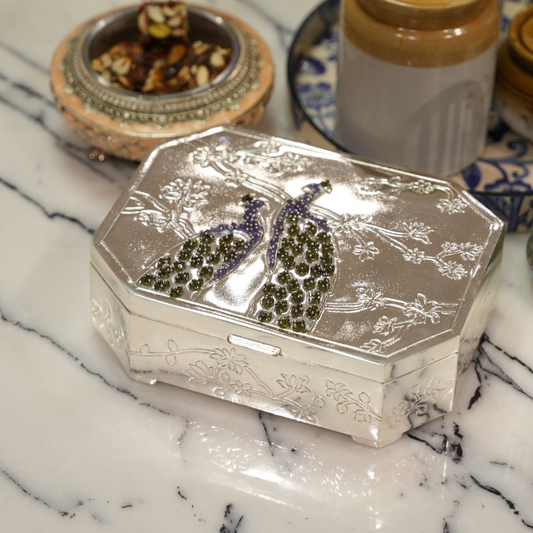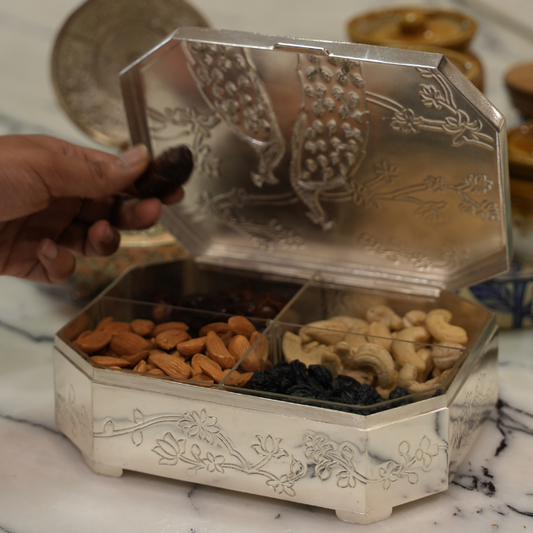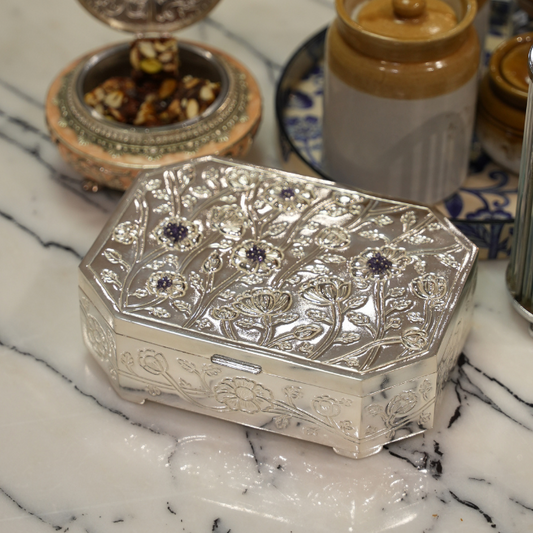Maharani by Rungtas’s guide on how to identify pure silver equips buyers with everything they need to distinguish genuine silver from counterfeits. It explains the difference between fine silver (999) and sterling silver (925), outlines the risks of fake silver, and describes six easy home tests—visual inspection, touch and texture, magnet, ice, sound, and chemical assays. For absolute certainty, it also covers professional methods like X-ray fluorescence and spectrometer testing. Finally, it highlights Maharani by Rungtas’s rigorous certification process—hallmarks, documentation, trusted sourcing, and artisanal quality control—so customers can invest confidently in authentic, heirloom-quality silver.
When it comes to purchasing silver jewelry, pooja essentials, or luxury silver gifts, knowing how to identify pure silver is essential. Authentic silver carries lasting value, superior durability, and cultural significance—especially in India’s rich heritage of silver craftsmanship. This guide explains the science behind silver purity, highlights common pitfalls with counterfeit items, and offers practical home tests, so buyers can distinguish genuine silver from fakes. Maharani by Rungtas takes pride in offering only certified, hallmarked silver products, ensuring every purchase meets the highest standards of authenticity.
What Is Pure Silver?
Pure silver, also known as Fine Silver (999), is composed of 99.9% silver and 0.1% trace elements. It is softer and more ductile than alloys but tarnishes more easily. By contrast, Sterling Silver (925) contains 92.5% silver and 7.5% other metals—usually copper—to improve strength and workability.
|
Grade |
Silver Content |
Common Use |
|
|
Fine Silver (999) |
99.9% |
High-end jewelry, collector coins |
|
|
92.5% |
Every day, jewelry, utensils and decor |
Hallmarks and certification stamps—such as “999” or “925”—provide quick visual proof. Recognizing these marks is the first step in learning how to identify real silver versus silver-plated or mixed-metal alternatives.
Why is Identifying Real Silver Important?
The market abounds with silver-plated and counterfeit silver items that mimic genuine silver’s appearance.
However, fake silver can pose:
Financial risks: Lower resale value and rapid wear.
Health concerns: Allergic reactions from base metals like nickel.
Durability issues: Prone to flaking, discoloration, and breakage. By mastering techniques for how to identify original silver, buyers safeguard their investments and ensure each piece, from pooja idols to heirloom jewelry, retains its beauty and value over time.
Methods to Identify Pure Silver at Home
1. Visual Inspection
Hallmarks & Stamps: Look for “999,” “Sterling,” “925,” or the BIS hallmark.
Tarnish Patterns: Pure silver develops a uniform, grayish tarnish; plated items often show uneven discoloration or flaking.
2. Touch & Texture Test
Temperature Sensitivity: Pure silver feels cooler to the touch than plated metals.
Weight & Smoothness: Genuine silver is denser and heavier; edges should feel smooth and solid, not hollow or rough.
3. Magnet Test
Silver is non‑magnetic, so any attraction to a magnet indicates the presence of ferrous metals. This simple “how to identify fake silver” test can quickly flag counterfeit items.
4. Ice Test
Due to silver’s high thermal conductivity, an ice cube placed on genuine silver will melt noticeably faster than on stainless steel or plated surfaces.
5. Sound Test (Ring Test)
Real silver produces a clear, bell-like ring when tapped lightly. A dull thud suggests lower‑quality alloys or plating.
6. Chemical Tests
Nitric Acid: Apply a drop to an inconspicuous area.
Pure silver turns creamy white; base metals often produce green or brown discoloration.
Silver Test Solutions: Available in kits, these reagents offer a safe way to confirm silver content.
How to Identify Fake Silver?
Counterfeit silver often uses base metals such as nickel, zinc, or copper. Key indicators include:
1. Flaking or peeling plating
2. Discolored edges or seams
3. Lack of proper hallmarks
4. Unusual weight or temperature response
Understanding how to identify fake silver helps buyers avoid common traps and choose investment-grade pieces.
Professional Silver Testing & Certification
For precise analysis, experts use
1. X‑Ray Fluorescence (XRF): Non‑destructive testing that measures metal composition.
2. Spectrometer Testing: Laboratory-grade verification of silver purity.
Maharani by Rungtas partners with accredited labs to certify every product, ensuring true identification of pure silver standards.
How Maharani by Rungtas Ensures Silver Authenticity
Maharani by Rungtas’s commitment includes:
1. Certified Hallmarks: All items bear BIS or international purity marks.
2. Detailed Documentation: Accompanying each purchase is a certificate specifying metal grade and test results.
3. Strict Sourcing: Only trusted refineries and assay offices supply the silver.
4. Artisanal Craftsmanship: Expert silversmiths adhere to traditional and modern quality controls.
Customers can buy with confidence, knowing each piece meets rigorous purity benchmarks.
Conclusion
Learning how to identify pure silver protects both the buyer’s health and wallet. From simple home tests—like the magnet and ice tests—to professional XRF analysis, these methods ensure genuine quality. By choosing hallmarked pieces from reputable sources such as Maharani by Rungtas, buyers invest in silver that will retain its beauty, value, and cultural significance for generations.
Frequently Asked Questions
Q1: How can I tell if a silver idol or pooja item is authentic?
Check for purity stamps (999 or 925), perform a tarnish test, and compare weight against known standards.
Q2: Why does real silver change colour over time?
Natural tarnish occurs when silver reacts with sulphur in the air—an indicator of authenticity.
Q3: What should I look for when buying silver jewelry?
Always verify hallmarks, examine the finish, and ask for certification from trusted brands like Maharani by Rungtas
Q4: Where can I find authentic hallmarked silver in India?
Specialist stores such as Maharani by Rungtas offer a curated selection of certified pure silver items.
Q5: What makes Maharani by Rungtas different from regular silver stores?
Their unwavering commitment to purity, exclusive designs, and an end‑to‑end certification process ensures genuine, luxury silver craftsmanship.







